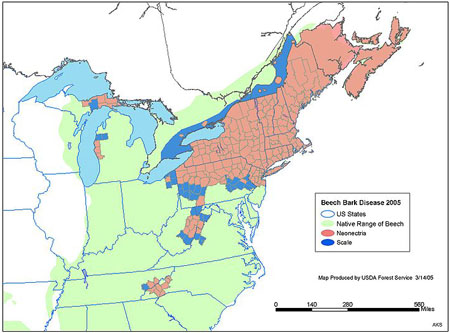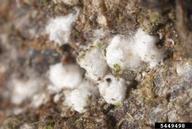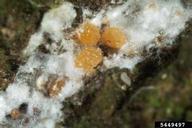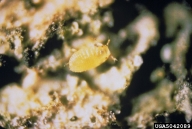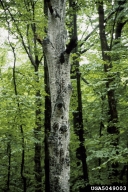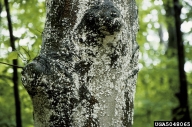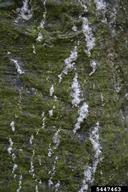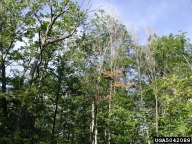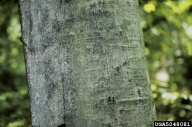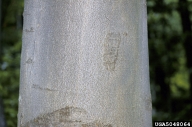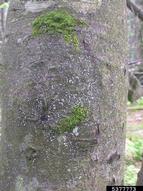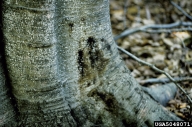Beech scale
Cryptococcus fagisugae Lindinger (Hemiptera: Eriococcidae)
Orientation to pest
Beech scale, Cryptococcus fagisugae Lindinger, is invasive in the United States and very likely also invasive in Europe. Its native range is believed, based on studies of mitochondrial DNA, to be in western Asia (Turkey and the Caucasus Mts) or southeastern Europe, where its host is oriental beech (Fagus orientalis Lipsky). It is a moderately damaging pest in Europe on European beech (Fagus sylvatica L.) and a devastating pest in North America of American beech (Fagus grandifolia Ehrh.). The insect infests the trunk of beech, inducing cracking which allows invasion by fungal pathogens (genus Neonectria), which kill the trunk. Roots survive and trees regenerate, but the disease cycle is too frequent to permit most trees to reach large size. Trunks are deformed by cracking and the development of cankers. Visible signs are the white woolly coverings of scales and the red fruiting bodies of the Neonectria fungus. About 1% of American beech are naturally immune from attack and remain healthy. Following the accidental introduction of the scale to the Halifax Arboretum in the late 1800s, an epidemic of beech bark disease has spread south and west, and now covers a substantial part of the range of American beech. This insect is apparently completely parthenogenetic; no males have ever been found.
Hosts commonly attacked
Oriental beech (F. orientalis) is believed to be the native host. European beech (F. sylvatica) and American beech (F. grandifolia) are hosts acquired in invaded areas.
Distribution
In North America, beech scale occurs from Nova Scotia to central Pennsylvania, with infested pockets in West Virginia, North Carolina, and Michigan, but continues to spread. In Eurasia, the scale is found from the United Kingdom to Iran. It is found throughout Europe; however, this area is no longer believed to be the native range. Of areas studied so far, mitochondrial haplotype diversity is greatest in the Caucasus Mts. and that area may be part of the original range of this insect. Surveys are underway in the Caucasus Mts. of Georgia for parasitoids of this scale.
| Figure 1. Distribution of beech scale, Cryptococcus fagisugae, and its associated invasive pathogen in North America in 2005, following its introduction in about 1890 in Halifax, Nova Scotia |
Images of beech scale
| Figure 2. Close up of beech scales, Cryptococcus fagisugae, under their woolly coverings (left) and with wool removed, showing orange scale bodies (right) | Figure 3. First instar nymph (crawler) of beech scale | |
| Figure 4. View of trunk of American beech infested with beech scale (light colored material) | Figure 5. (Left) Beech scale on bark of severely damaged American beech (note also lumpy cankers on trunk caused by beech bark disease); (Right) close up of colonies of beech scale | |
| Figure 6. Beech trees in forest killed by beech bark disease | Figure 7. Cracked bark of tree with beech bark disease (left) compared to smooth grey bark of healthy American beech (right) | |
| Figure 8. Bark cracking and growth of epiphytes (here, moss) on trunk are other signs of beech bark disease | Figure 9. Dark weeping spots are also a sign of beech bark disease | Figure 10. Discoloration under bark due to Neonectria cankers | Figure 11. Orange fruiting bodies of Neonectria on beech bark |
Important biological control agents related to this pest species
No parasitoids of this scale are known from either North America or Europe. Studies in both regions found only generalist predators attacking the scale. Currently efforts to find parasitoids are underway in the Caucasus Mts., the region now believed to be at least part of the native range of the scale.
Web links for information on beech scale
- Research Publications | Cary Institute of Ecosystem Studies
Links to publications on the effects of the beech bark disease on Catskill forests - Research Article | USDA Forest Service, Northern Research Station
"Development of DNA Based Markers to Identify Beech Bark Disease-resistant trees in natural stands" - Threat Summary | Eastern Forest Environmental Threat Assessment Center
- Wikipedia Article | Wikipedia, the free encyclopedia
- Species Catalog on ScaleNet
Complete list of all recorded natural enemies, hosts, and distribution records; also an index to all publications on this species
Articles
- Van Driesche, R. G., S. Healy, and R. C. Reardon. 1996. Biological Control of Arthropod Pests of the Northeastern and North Central Forests in the United States: A Review and Recommendations FHTET-96-19 USDA Forest Service, Morgantown, West Viriginia, USA, see pp. 20-22.
- Forrester, J.A., G. G. McGee, and M. J. Mitchell. 2003. Effects of beech bark disease on aboveground biomass and species composition in a mature northern hardwood forest, 1985 to 2000. Journal of the Torrey Botanical Society 130(2): 70-78.
- Gwiazdowski, R. A., R. G. Van Driesche, A. Desnoyers, S. Lyon, San-an Wu, N. Kamatad and B. B. Normark. 2006. Possible geographic origin of beech scale, Cryptococcus fagisuga (Hemiptera: Eriococcidae), an invasive pest in North America. Biological Control 39: 9-18.
